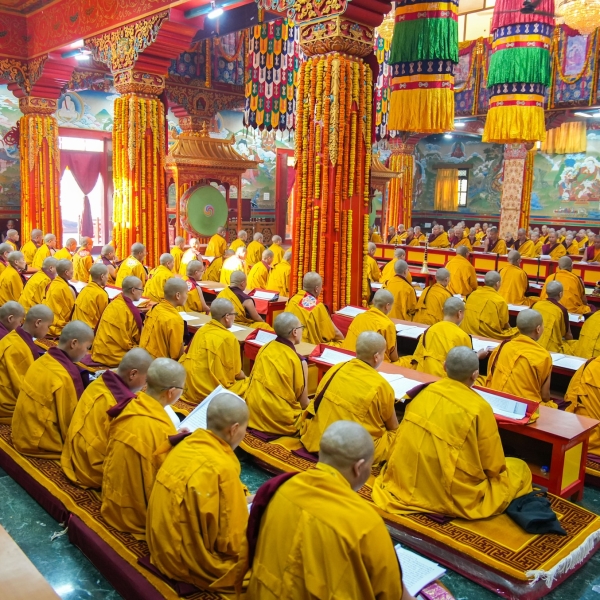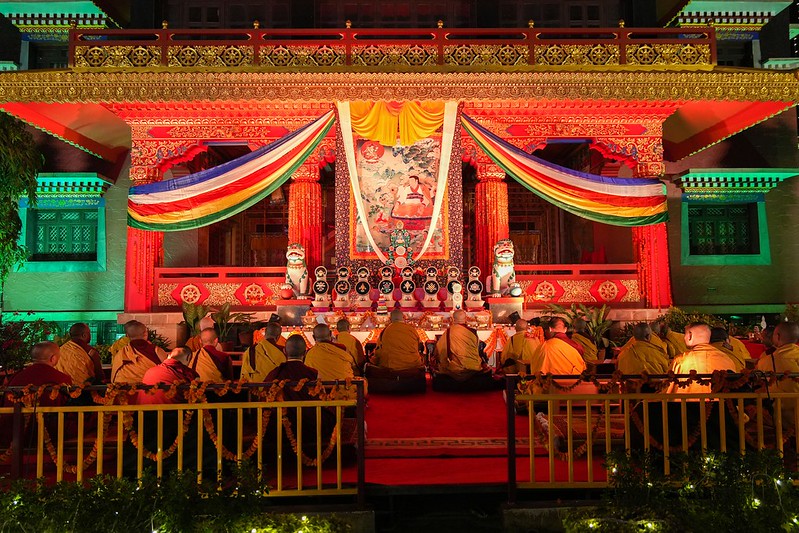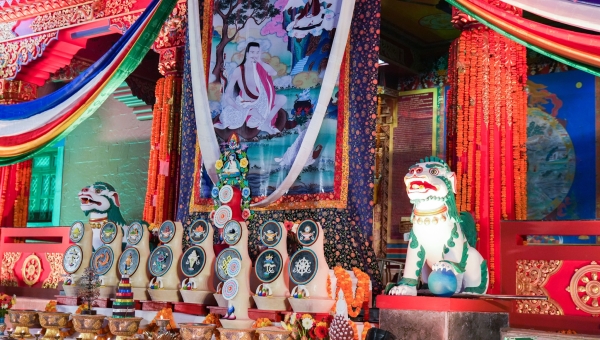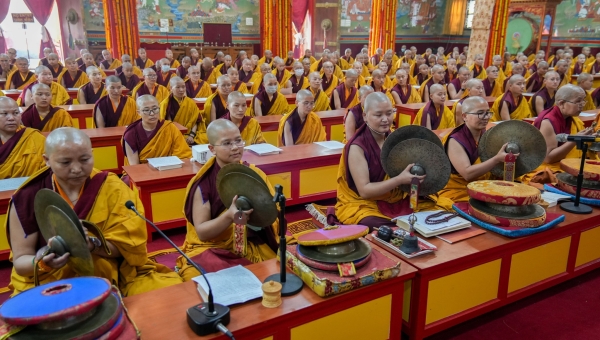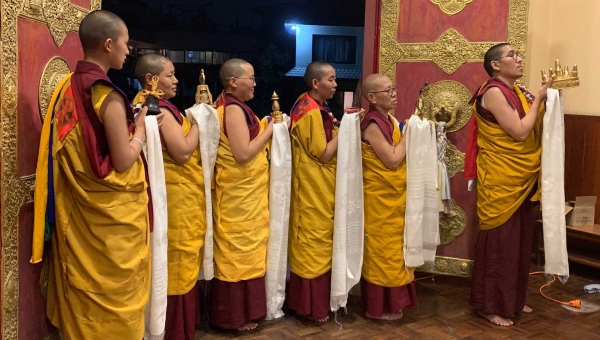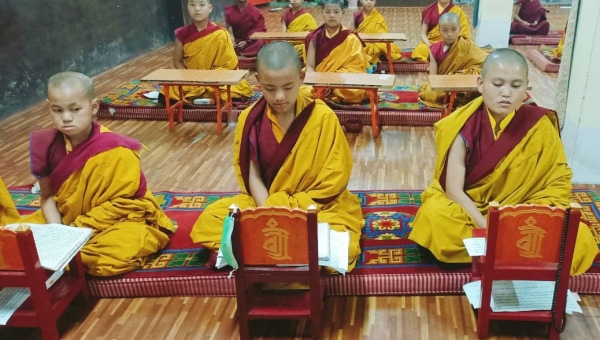Arya Kshema Spring Dharma Teachings: 17th Gyalwang Karmapa on the 8th Karmapa Mikyö Dorje’s Autobiographical Verses
April 19, 2022
His Holiness began the thirteenth day, which was also the last day, of the Arya Kshema Spring Teaching, by expressing his intention to teach the twenty-first stanza, which is on ultimate bodhicitta, and the rest of the autobiographical verses Good Deeds and The Praise 'He Searched Thoroughly' next year.
In relation to Mikyö Dorje’s deeds and liberation, Karmapa expressed that he would like to speak particularly about something connected with the nuns, since we were having the Spring Teaching for the nuns.
His Holiness related that a few years ago, there were several conferences in Dharamsala on the topic of bhikshunis. At that time, he received a document by Tsele Natsok Rangdrol that was surprising—it described how Mikyö Dorje gave bhikshuni vows. It was titled A History of How the Teachings were Established at the Three Tsele Monasteries, and it read:
Lady Jetsunma Könchok Tsomo received full ordination from Lord Mikyö Dorje and became a bhikshuni. She observed all the rules meticulously and without any fault. She taught over one hundred nuns at Shokhang Nunnery, living a long life and perfecting her practice. She became venerated by everyone in the region of Taklung.
“So here, when it says Lord Mikyö Dorje, of course there were many Mikyö Dorjes in Tibet, but the one at this time, we should understand as Karmapa Mikyö Dorje, since the three Tsele monasteries were all related to him,” His Holiness clarified. The other surprising fact was that no text other than this one mentioned the topic of giving bhikshuni ordination—not in Mikyö Dorje autobiographies or in writings by other authors.
The Karmapa expressed his surprise at the time, because he had never seen or heard of this text before. “When we saw this text from Tsele, we began to consider what the connection between Mikyö Dorje and the bhikshuni ordination was, and we began new research into it. If we look more closely, there are many points—both major and minor—related to bhikshuni ordination in Mikyö Dorje’s collected work. He spoke about the precepts for bhikshus and bhikshunis as well as the precepts of novice monks and nuns, but this is not all. It is also important how he put this into practice in his lifetime.”
Karmapa recollected that in 2004, when he was reforming the codes of conduct for the Kagyu Monlam, he saw a text by Mikyö Dorje on the Vinaya rituals, which detailed the manners of making offerings, wearing dharma robes, and so forth. That was the time when he began to take more interest in bhikshunis. As a result, a special seating area was prepared for bhikshunis at the Kagyu Monlam, and both bhikshus and bhikshunis participated in the Kangyur and alms processions. The main cause of this was this particular text on the Vinaya rituals, he stated.
His Holiness then introduced the title of the text A Presentation of the Motions of the Sangha, Motions for Individuals Related to the Sangha, and Motions for Individuals. The meaning was that:
The practice of the rituals is accomplished as is seen. The rituals for women cannot be practiced in Tibet these days, so if a woman wishes to take full ordination, it is appropriate to give full ordination according to the ritual for men. The bhikshuni vows primarily arise on the basis of the male bhikshu sangha, and when there is the ritual for women, the gathering of the dual sanghas is merely the proper and appropriate way according to tradition. As the Sutra says, “Bhikshunis are fully ordained by the bhikshus and are granted the vows of bhikshus.”
This is because the long commentary says, “The gathering of the bhikshuni sangha is merely according to tradition…” and “Actions performed by bhikshus and bhikshunis, when done by others, are not unaccomplished.” Therefore rituals for bringing women forth and giving them full ordination on the basis of rituals for men are mostly similar as for men, and the few differences may be filled in and stated.
The main point of this passage was that since there was no bhikshuni sangha in Tibet, if women wanted to become bhikshunis, the male bhikshu sangha would be allowed to give the women’s vows, explained Karmapa. The ritual was to be based on the ritual for men, and the passages required altering, for example, saying novice nun instead of novice monk. “When I first saw this text, since I had yet to see the text by Tsele Natsok Rangdrol, I had not thought that Mikyö Dorje had given the bhikshuni vows. It occurred to me that he must have given some thought to this matter. Later, after I saw how he had given bhikshuni vows, it seemed to me that perhaps he had given the bhikshuni ordination with that very same ritual he had altered for ordaining women,” Karmapa shared.
Other than this passage by Tsele Natsok Rangdrol, there were very few other sources about Mikyö Dorje giving bhikshuni vows, he explained. Thus, we cannot determine definitively that he gave the bhikshuni ordination. Karmapa then pointed out that if we took some interest and looked more closely at the matter, it would be very clear that there were students of Karmapa Mikyö Dorje who were bhikshunis.
He continued by explaining that the Ma dak ma, translated as “the impure prayer,” is a Mahakala text that we recite daily. In Tibetan, there is a tradition to take the first few words to give a text its name. The colophon of the text reads:
Written by Mikyö Dorje at the request of Rinchen Palmo.
Likewise, the colophon to the Selected Prayers in Mikyö Dorje’s collected works reads:
Composed by Karmapa Mikyö Sangpo Dorje Away Yang at the request of Rinchen Palmo, who is rich with faith.
Karmapa explained that Rinchen Palmo’s name appeared here twice, on two occasions. The name “Rinchen Palmo” on its own only indicates a female student and does not mean anything else in particular. But when we look at the colophons of other texts that she requested, we can see that “Rinchen Palmo” was not just anyone. In a text titled, The Light of Profound Suchness: An Uncommon Meditation on Guru Vajrasattva, the colophon reads:
Thus this uncommon meditation on the guru Vajrasattva from the oral tradition of the Gyalwang Karmapa was written as a few notes as a reminder about meditation for the Shakya Bhikshuni with a faithful and devoted mind, Rinchen Palmo.
This clearly proved that Rinchen Palmo was not just anyone; she was a bhikshuni. Unfortunately, at this point we do not have a detailed account of Bhikshuni Rinchen Palmo’s life, but in the collected songs of Pawo Tsuklag Trengwa called The Garland of Secret Words: A Treasury of Vajra Songs, there is a song that reads:
Meditate on the main practice of the Mahayana,
Aspirational and engaged bodhicitta.
Get to the main points of devotion, guru yoga.
Gain clear appearances of the deity in the creation phase.
Rest uncontrived and loose in the essence of meditation.
Whatever appears, purify it into deity, mantra and great bliss.
Do not be attached to body or any possessions,
Eject your consciousness, the letter a, into the sky.
The essence of dharma teachings is contained in these.
Though I was asked to write notes on instructional advice I had given to Lady Rinchen Palmo, I did not have time and only wrote these seeds.
“Looking at this, it seems that Rinchen Palmo was first a noblewoman who later became a bhikshuni. I think she was connected with Taklung, but not definitively. In any case, we must examine whether she is the same as the Könchok Palmo mentioned above,” Karmapa pondered. Generally, when we translate the Sanskrit word ratna, it would be ‘rinchen’ in Tibetan if translated literally, but it would be ‘könchok’ if translated based on its meaning. Thus, it seemed that there was a choice between Rinchen and Könchok, so it was possible that she was named ‘Rinchen Palmo’ here and was known as ‘Könchok Palmo’ in other places. However, Karmapa added that it was hard to determine definitively that it was her.
If Karmapa Mikyö Dorje had given the bhikshuni ordination, was it appropriate and according to the vinaya rituals? Historically, there were two ways to become a bhikshuni, either through a dual sangha or through a single sangha; in Tibet, it seemed that bhikshunis were ordained by a single sangha. To help us understand this issue better, Karmapa went on to provide some historical background.
The Historical Background
I. There are differing accounts of the initial spread of Buddhism in Tibet, but according to the most reliable sources, it seemed to have been during the reign of King Songtsen Gampo, explained Karmapa. This can be known from the edicts of Sena Lek and Trisong Detsen, the inscriptions on the pillars from Karchung and Samye temples. The inscriptions in Samye about the development of a monastic community read:
Representations of the three jewels were built, and people from Tibet also were brought to liberation.
This was during the time of Trisong Detsen. Here, “brought to liberation” meant allowing them to go forth (take ordination), and “people from Tibet also…” seemed to indicate that Tibetans must also have gone forth.
Likewise, within the Tengyur’s section on letters, the colophon to the Letter Summarizing What to Cherish Sent by Ba Palyang reads:
In Tibet, there was not even a word for bhikshu, and then the lord bodhisattva Trisong Detsen found the true dharma. The glorious emperor roused faith and said, “the one with the monastic name Palyang is a perfect monastic.”
This stated that prior to Ba Palyang, there were no bhikshus. He was the first Tibetan monastic, explained Karmapa.
In addition, an old manuscript of the Chronicles of Ba found in Drepung said:
Some histories say that at that time of Songtsen Gampo, the translator Sambhota, Chökyi Dzö, and others went forth, but this is nonsense from people who do not know when the Seven Men for Testing [the first seven people to take monastic vows] lived.
This refuted those who said that there were monastics during the time of emperor Songtsen Gampo. Prior to Trisong Detsen, there were no monastics in Tibet. If there were, they were Chinese monks or monastics from other regions; it seemed that no sangha community of Tibetans had developed at that time.
Karmapa stated, “It is generally accepted that the first Tibetan monastics were during the time of Trisong Detsen. The khenpo who gave them the vows was Śāntarakṣita, and the people who took the vows were the six or seven men for testing.” This was clearly found in the old manuscript of the Chronicles of Ba:
On the full moon of the first month of spring of the Year of the Sheep, the seven of Chim Shakyaprabha, Tsang Lekdrup, Pa Or Bhairotsana, Shang Lhabu, Shöbu Khonglen, and Wa Yeshe Wangpo went forth with master Śāntarakṣita.
This text also mentioned something previously unknown:
Some explain that Śāntarakṣita was from the Tāmraśāṭiyā school, but those who say that the seven men for testing acted as translators and Dānaśila ordained Palgyi Yeshe, saying he was the earliest Tibetan monk, do not understand the meaning of the seven men for testing.
It seemed that there were people who asserted that Śāntarakṣita was not the abbot who ordained them. Karmapa then indicated that we can tell when the first monastic community was founded by knowing when they were ordained.
He continued by pointing out that in the Chronicles of Ba, there was record of not only men who went forth but also women:
Then Kharchen Sa and Jangchup Je went forth with three hundred subjects…
In some documents, after Samye was built but before it was consecrated, Wa Salnang went forth and was given the name Yeshe Wangpo. In the Year of the Sheep (the year 767), during the great consecration rituals, Wa Ratna was the abbot when Lady Chen Trigyal and one hundred subjects went forth.
“It gives different situations on how women went forth, but later it became well-accepted that the abbot who first ordained women in Tibet was Wa Ratna,” explained Karmapa.
From an ancient Chinese manuscript found at Dunhuang called Ascertaining The Logic of the Mahayana Sudden Enlightenment:
Queen Tri Jemo Tsen had great faith and devotion from the very beginning and awakened to realization in an instant. She therefore cut off her deep black hair and wore the saffron-colored banner. The jewel of stainless discipline illuminated the mandala in her heart, and through the clear water of samadhi she realized the nature of zen. This deed cannot be exemplified even by a lotus unstained by the mire. The Master was skilled in means for taming beings, so he always taught the emperor’s sister Trina Namsa and over three hundred wives of ministers the Mahayana dharma. They all went forth on one occasion. What difference is there between her and Mahaprajapati?
Karmapa said this explained that Queen Tri Jemo Tsen, the king’s sister Trina Namsa, and over three hundred wives of ministers went forth. The abbot who ordained them was not clearly stated to have been Abbot Mahayana. However, His Holiness speculated, Abbot Mahayana and their ordination were most likely closely connected because they went forth due to his teaching the dharma.
By comparing the Chronicles of Ba and the Ascertainment, we can learn that the first Tibetan bhikshuni was the queen of emperor Trisong Detsen—Tri Gyalmo Tsen. There were two other pieces of evidence related to her story: the inscriptions on the bells of the Samye Gegye Temple and the Tradruk Temple. The former was probably built before she went forth, and the latter after.
Showing us a picture of the bell from Samye Gegye Temple, Karmapa read the inscriptions on it:
The Lady Queen and the Prince, as an offering to the three jewels in the ten directions, erected this bell. By the power of this merit, may Emperor Trisong Detsen, his princes, and their wives have voices with the sixty qualities and achieve unexcelled enlightenment.
The inscription on the Tradruk Temple bell read:
This large bell is very well known in the time of Emperor Tride Songtsen. In order to inspire all sentient beings to virtue, like the sound of the drums of the gods that is heard in the sky, this bell was sponsored by Jomo Jangchup and cast by Khenpo Gya Bhikshu Rinchen.
The latter inscription stated the sponsor of the bell was Jomo Jangchup, the name given to Tri Gyalmo Tsen after she became a bhikshuni. These two bells were evidence that she was a very important historical figure, Karmapa pointed out.
In any case, whether the khenpo who ordained them was Wa Ratna or Khenpo Mahayana, the source for the ordination was the male sangha—it was clearly not a dual sangha. Another source that indicated that there were both male and female bhikshus at that time was the Letter Summarizing What to Cherish Sent by Ba Palyang which wrote:
Now give instructions to the bhikshus, novices, and bhikshunis who have gone forth.
It instructed that advice should be particularly given to the bhikshus and bhikshunis, making it clear that there were bhikshunis in Tibet during the ancient spread of the teachings.
Returning from the intermission, His Holiness continued his overview of the historical background regarding Karmapa Mikyö Dorje giving bhikshuni ordination.
II. In the tenth century, as the later spread of the teachings to Tibet began, there was also an ancient inscription by Lha Lama Yeshe Ö, which said that if ladies were able to become bhikshunis, instead of stopping them, they should be sent to liberation and a dharma house should be built for them.
Karmapa elaborated, “This means that all the wives of ministers and people of high status who were able to become bhikshunis should not be prevented; they should be allowed, and temples and nunneries should be built for them. There is this inscription giving this edict.”
Likewise, the liberation story of Rinchen Sangpo by Jñāna Śrī also supported the presence of bhikshunis. Rinchen Sangpo had three siblings, among whom the youngest was his little sister Sherap Tsomo who became a bhikshuni. She studied tantric dharma and attained siddhis through her practice, becoming known as Naljorma Chökyi Drönma. This account clearly shows there were bhikshunis at that time.
III. In the thirteenth century, the third wife of Drogön Chöpak’s father Sangtsa Sönam Gyaltsen, the oldest daughter of a king, was ordained by the female master Sönam Bum. She founded a nunnery called Chomo Ling. It was said that she had taken bhikshuni vows, and Drogön Chöpak himself said:
I was the abbot for 4425 bhikshus, bhikshunis, novice monks, novice nuns, and people who went forth from Nepal, India, China, Western Xia, Mongolia, Kaule [Korea], Jangu, Uighur, Shusen, and other places.
This was found in Taktsang Paljor Sangpo’s Treasury of Documents to Please Scholars, compiled in 1434. “In any case,” Karmapa emphasized, “this proves that there were bhikshunis in the thirteenth century.”
IV. In the thirteenth century, Kashipa Rigpe Senge, one of the five scholars from Minyak, followed the vinaya master Sönam Drak, from the same lineage of Butön Rinpoche’s guru, Jamkya Namkha Pal, and Tsi Dulzin. He helped to spread the dharma widely, in central Tibet and in Western Xia [Tangut Empire 1038 to 1227]. According to the liberation story by his direct disciple Seng Sang, his students included one hundred bhikshunis.
V. The vinaya master Namkha Sönam, born in the latter part of the fifteenth century, was very well-known at that time. He was the khenpo who ordained Chuwar Rangjung Wönmo as a bhikshuni, according to Gorampa’s dialogs The Blossoming Lotus.
VI. Toward the end of the fourteenth century, according to a letter in the Collected Works of Redawa Shonnu Lodrö called Advice to the Lady of Yardrok, Chöpal Sangmo, it was written: “Geshe Yeshe Pal brought the letter of the Lady Bhikshuni along with the cape, and I rejoice.” At the end it also said, “This is advice from the child of snow Le to Bhikshuni Pal Sangmo.” Thus it was clear there were bhikshunis at that time, indicated Karmapa.
VII. At the beginning of the fifteenth century, the first Samding Vajra Varahi Chökyi Dronme, or Shelkar Dzommo, first took novice ordination from Bodong Panchen Choke Namgyal and was named Adrol Chökyi Dronma. Later, she took bhikshuni ordination from Bodong Panchen, who acted as the abbot, and the complete sangha of bhikshus. This topic was described in detail in Jetsunma Chökyi Dronme’s liberation story.
Karmapa related that the next day after she had taken the bhikshuni vows, she was invited to lunch by Bodong Rinpoche. She brought her alms bowl and brought along her attendant who was a novice nun. Bodong Panchen was inspired by her and said, “A female arhat has come down to Earth from the heavens.” This was described very clearly in her liberation story.
VIII. At the beginning of the fifteenth century, a woman named Sangdawa Shakya Budrenma went forth under the vinaya master Lobsang Pukpa and was named Shakya Die. Later, she took bhikshuni ordination from Goyap Khenpo Sangye Sangpo and was given the name Shakya Sangmo. When she took dharma teachings from the Khenpo, she experienced a crystal made of light appearing repeatedly inside her body, so she asked the Khenpo about it. Karmapa remarked that the Khenpo was probably a practitioner of pacification. The Khenpo rested in meditation and replied, “You will bear or give birth to a great being who will uphold, preserve, and spread the teachings of the Buddha. It will be just as how in the past in India, the Brahmin lady Salway Tsultrim, who was first a nun and became a laywoman, bore Asanga with someone from a Kshatriya class and Vasubandhu with a Brahmin. So do not stay here; return to your homeland.” Later, she returned her vows and became the mother of Panchen Shakya Chokden. Karmapa added that this was explained in two liberation stories of Shakya Chokden, the Precise Account and The Illuminator of the Buddha’s Teachings.
IX. In the middle of the fifteenth century, when Panchen Shakya Chokden was sixty-two, it was said in his liberation story The Illuminator of the Buddha’s Teachings:
Gyama Chödrup Palmo was ordained a bhikshuni with Shakya Chokden as khenpo, Chennga Drupgyal as the ritual master, Kungyal as the private questioner, Je Drakmar as the master assisting the private questioner, Drung Palsangwa as timekeeper, Chöje Samten as the assistant, and four masters to fill out the ceremony.
These historical documents support the case that Mikyö Dorje did give bhikshuni vows. Karmapa emphasized the importance of this, “When we research the above accounts, we see that most people who took bhikshuni ordination in Tibet in the past were of high status, from the families of lamas or the noble. That is primarily the type of woman it was. Thus, it could be that the lineage was later broken since there were few commoners who took bhikshuni vows, or it could have been due to other circumstances. We cannot say definitively, so we need to continue to research this topic.”
Not only were there bhikshunis in Tibet prior to the sixteenth century, it seemed that at one point during that period, there were an equal number of monasteries and nunneries in Ütsang. Karma Chakme said in his text Important Dharma Teachings for Nuns to Be Self-Sufficient in Dharma:
In the pure land of Ütsang,
The monasteries and nunneries
Are neither more nor less.
In some nunneries, the nuns
Are three or four hundred in number.
There are many nun gurus and discipline masters.
They established strong discipline,
And the nunneries were good. Thus most
Were able to become self-sufficient in the dharma.
I have not heard of such happening
Here in Kham and Ngomshi.
Protectors of dharma are like stars in the daytime.
At that time, there were equal numbers of monasteries and nunneries. In particular, Karmapa mentioned that there were many lamas and discipline masters who were nuns in these nunneries and had rules to keep men from outside coming in. Many of the early Kadampa monasteries in Penyul were later converted to nunneries. On the other hand, in Kham where Karma Chakme was from,; nunneries were rare. “However, later there were political changes in Ütsang and there began to be hostility toward nuns; people started to look poorly on the nuns and there was a decline in the nunneries. But up until the seventeenth century, the nunneries were flourishing,” exclaimed Karmapa.
He added, “Looking at the situations I have already mentioned, from the introduction of bhikshuni vows in Tibet, probably about ninety-eight percent of the bhikshuni ordinations were performed by the bhikshu sangha.” The vows of a laywoman, vows of going forth, and novice nun vows may be taken from individuals. The first and last of these are taken from a female master, and the vows of going forth from an abbess. The nun in training, celibate upavastha, and bhikshuni vows are taken from the sangha; the nun in training vows are taken from a sangha with the female master, and the celibate upavastha vows must be taken from sangha with an abbess.
Karmapa explained that in the vinaya, among the ten ways to be fully ordained, there are primarily three for women:
1. Gaining full ordination by accepting the eight heavy dharmas
2. Full ordination by messenger
3. Full ordination by the dual sangha
In places where there is a male bhikshu sangha but no female sangha, there is a way to have a faultless and complete ordination. The Minor Topics of the Vinaya said:
Know that the woman named this went forth with the bhikshus and was fully ordained and became a bhikshuni.
Regarding the meaning of this, the extensive commentary by Master Gelek Shenyen explained:
Saying “bhikshus” excludes bhikshuni… The full ordination of bhikshunis depends solely upon the sangha of bhikshus.
Likewise, the auto-commentary on the Vinaya Sutras stated:
If a nun in training is fully ordained with the ritual for bhikshus, because the bhikshu sangha is the primary sangha, the gathering of the bhikshuni sangha is merely in accord with tradition.
In Tibet, the most well known vinaya commentary by Tso Ngawa said:
If there are not four, it will not arise here, because the motion is not passed. If the bhikshunis are not found, it is permissible for the male bhikshu sangha to give the precepts of a nun-in-training.
Karmapa explained that it is commonly accepted in all four schools of Tibetan buddhism for men to act as the abbot for going forth and the master for novice nuns and give vows. If there were no way for women to receive vows from male bhikshus, or if they could receive the ordination but it would not be faultless and perfect, there would be no way to ordain women in Tibet; thus there would be the danger of saying that there were no nuns in Tibet. He reminded us this was another point to keep in mind.
In the Chapter on the Rains Retreat, it was mentioned that bhikshus would go out to ordain nuns in training and the celibate upavastha.
Similarly, the Sutra of Mahaprajapati translated into Chinese in the fifth century wrote:
After the Buddha passes to nirvana, if there were a woman who seeks the spiritual way, is it appropriate for bhikshunis to be the abbess and master?
The Buddha said to Ananda, “If she is an elder bhikshuni with the qualities of discipline, it is appropriate. Even so, it depends upon the bhikshu sangha. If the assembly is complete, it is appropriate, but if it is short one bhikshu, she should not be ordained.”
Again, Ananda asked the Buddha, “In that case, is it logical for bhikshus to be the abbot and master?” The Buddha replied, “It is not. Great bhikshunis are allowed to act as the abbess and master. If there are no bhikshunis, then it is logical for the bhikshu sangha to do so.”
This practice seemed to have been present with early Tibetan vinaya masters. Karmapa pointed out that we can know this from the scholar Sherap Gyatso, from the great Kadampa monastery of Narthang, who wrote in his commentary on the vinaya that, “If there are no bhikshunis, the bhikshus may give all the vows.”
In brief, he summarized that if one had not previously taken the nun in training vows and was ordaining as a bhikshuni, the vow would still arise. Butön Rinpoche also said, “The actual vow arises from the male sangha.” Most scholars agree that the bhikshuni vows actually arise from the bhikshu sangha. Therefore, the lineage of the vows was thus transmitted from the male sangha, not from the female, explained Karmapa.
Likewise, in China in the fourth century, the earliest bhikshuni was Jing Jian. She was probably ordained by a male sangha alone, he remarked. It was difficult to find examples of such during the time when buddhism flourished in India, since there were both bhikshus and bhikshunis in India.
“These days, we could say that the world has shrunk, or that travel has become easier,” Karmapa observed. “Even though bhikshuni vows can be given by the male sangha, that does not always necessarily mean it is best to do so. If we invite bhikshunis from other regions to give ordination, I think there is less basis for dispute and there are great benefits to doing so. A few years ago, I invited a sangha of bhikshunis from Taiwan to the sacred site of Bodhgaya to give the novice nun vows, and it turned out well.”
His Holiness expressed that in the future, when the epidemic has ended and we can once again travel easily, he would like to invite the bhikshuni sangha from another country again to give the novices the nun-in-training vows and then later the bhikshuni ordination. Within the practice lineage of Karma Kamtsang, this topic of bhikshuni ordination was not something he had decided alone, Karmapa clarified. It was a result of several conferences held during the Kagyu Gunchö among the khenpos, geshes, and students. At that time, the khenpos and geshes told him, “You should institute bhikshuni ordination in the Kamtsang Kagyu,” and he heeded the requests.
His Holiness then mentioned that some people argued that ordaining women would shorten the Buddha’s teachings by five hundred years, but a response was given in the second century in the Great Exposition.From the one hundred and eighty-third fascicle of the Great Exposition:
From the vinaya: “My teachings should remain over one thousand years, but it will be shortened by five hundred years because of women going forth.” As this says, the Bhagavan taught the true dharma in many places but did not define what true dharma is. Thus, that sutra is the basis for treatize, and this treatize has been written to explain what was not taught there…
The Buddha said to Ananda, “If women do not go forth in the dharma vinaya I have taught well, my dharma will remain one thousand years or even longer. Because women are going forth, my true dharma will be shortened by five hundred years.” As this says, if the teachings are to remain one thousand years, why would the Bhagavan have said that?
The treatize appeared after the first period of five hundred years, yet the teachings remained. Thus, why did the Buddha say this, and why are the teachings still here? His Holiness elucidated that there were two different explanations.
1. The teachings referred to the dharma intending stable liberation, of achieving the result of arhatship; it did not refer to the duration of teachings shortening.
2. Others explained that this was said in terms of not accomplishing the eight respectful dharmas, and Karmapa favored this explanation. If women did not accept the eight respectful dharmas, then the teachings would be shortened by five hundred years. But since they did accept them, the true dharma will remain in the world for a full thousand years.
If we did not understand the basis of this saying, then it would not be in accord with the teachings of the scriptures. “In the future, we need to be able to respond that it is inappropriate to say that women going forth will harm the teachings,” reminded Karmapa. “At that time in Indian society, women were looked down on and in a very low position. If the Buddha were to put women in a high place in society, it would have changed and decreased the level of respect people had. By taking the eight respectful dharmas, it does not reduce the teachings by five hundred years.”
Words of Advice
His Holiness emphasized that it was important for all our nuns to both study and practice. He said that even though traditionally monasteries were separated into different sections [shedra and tsokdra], for someone who is seeking liberation, study and practice have to be unified. This could be understood through the analogy: A bird which uses only one wing cannot fly. Likewise, we need to unite both study and practice to attain liberation. “Studying the texts is extremely important; if we do not know what we should and should not do, we will not know how to do the practice,” explained Karmapa. All nuns need to study, regardless if they are in the centers of study or practice.
Karmapa reminded us that in the past in Tibet, nuns did not have many opportunities. One reason was because many of them did not take much interest in studying. He explained, “They stayed in the form of nuns, and did not look for opportunities. It is important that we study the texts and philosophy. The aim for this is to practice, to tame your mental continuum and bring benefit to others.” Karmapa specified that this benefit does not refer to helping with food or clothing, but with the dharma. This is the responsibility of all dharma practitioners, he urged.
“When we think of studying philosophy in the shedra, we think it is like going to school. We think we are staying in a dharma community, and we are listening and contemplating the dharma, but we don’t really feel that, do we? I do not think that is good at all. It is extremely important for us to have study and practice together. In this way, our nunneries can be like great ornaments for the teachings of buddhism, and a great fertile field for the happiness of sentient beings,” he concluded.
After the usual dedication prayers, various monasteries and nunneries made mandala offerings to His Holiness, and a representative from the nunneries expressed gratitude towards His Holiness and the teachings in a short speech. The last session of this year’s Arya Kshema Spring Teaching ended with a recitation of The Aspiration of Mahamudra.

















